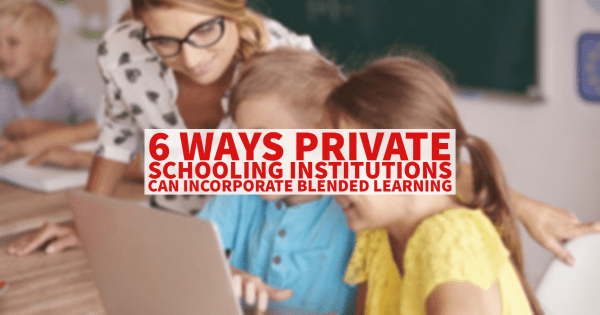
We live in a society saturated with gadgets and constantly changing technology. Generation Z and post-millennials have grown up around smartphones, tablets, personal computers, the internet, and social media. As such, educational systems need to reflect the real experience of living in a digital world. This is only possible by interweaving the latest technologies with traditional teaching strategies, a process called blended learning.
Integrating the approach in private schools is not as challenging, as the class sizes are relatively small. According to research, the average school size of private schools comprised 146 students in 2011 and 2012, which means a class has less than 20 students. Let’s look at ways blended learning is integrated into private schooling systems and the advantages of this approach.
What Is Blended Learning?
Blended learning is a method of teaching that integrates digital media and technology with traditional instructor-led classroom activities. As such, students enjoy more flexibility as they can customize their learning experiences. It also improves the student’s learning experience, boosting engagement and reducing the failure rate. Note a blended approach isn’t adopting an online course exclusively or broadcasting lecture courses online. Instead, online and in-person elements work together to create a rich learning experience.
Ways of Implementing Blended Learning
Blended learning is a mixture of direct instruction, collaborative teaching, and indirect instruction. Private schools in Kendall FL can implement the concept using the following different techniques.
1. Face to Face Teaching
Blended learning still provides the full scope of traditional teaching, as students interact with teachers face-to-face. The approach enhances synchronous communication because teachers have a direct effect on a student’s behavior, personality, and value system. Also, private schooling that uses face-to-face interaction enables both students and teachers to get immediate feedback.
2. Virtual Class Sessions
The classes allow students to learn from anywhere and at any time. The idea is to enable students to participate in class while interacting with the teacher and other students irrespective of their geographical boundaries. Some private schools in Miami adopt the approach to provide as much flexibility to students as possible. Therefore, students who can’t attend school regularly can take advantage of this mode of learning.
3. Interacting With Course Content
The traditional learning approach allows students to interact with the course content through printing material. Blended learning introduces ICT tools in the form of videos to provide much-needed realism to the course content. Some models also encourage the use of e-books and blogs.
4. Access and Maintenance of Educational Blogs
Traditional class settings hardly allow students to nurture their creativity because they focus on assignments, classwork, and examinations. Private schooling systems adopting blended learning should consider allowing students to create educational blogs. The idea is to create a platform where students can showcase their creativity and also get feedback. Also, they are an excellent platform for students to discuss important topics that aren’t part of the syllabus. They may write blogs about relevant and important issues in today’s world.
5. Learning Using Videos
Instructors using this approach look for animated videos and recordings explaining various concepts in an interesting way. Such videos use the principle of realism to help students understand and get a feel of real-life while studying. As a result, students understand difficult concepts easily. Another way of incorporating videos in online learning is to upload videos of lectures prepared by the teacher. As such, if the student can’t attend the class, they can still access the course’s content via videos.
6. Virtual Laboratories
This kind of learning is a little far-fetched but incredibly effective for students who need to perform dangerous experiments. Since it’s not safe for students to handle such equipment, the instructor can provide virtual labs so students can learn the required skills.
Benefits of Blended Learning
As with other teaching methods, blended learning has its advantages and disadvantages. Here are five benefits of incorporating it in private schooling systems.
- It’s flexible
- Encourages more student-teacher interaction
- Effective learning outcomes among students
- Increased interaction with student learning material
- Different learning approaches that can be tailored to address students’ learning needs
With the necessary training, teachers can implement blended learning effectively in classrooms. The numerous implementation methods help learners realize their academic potential.



